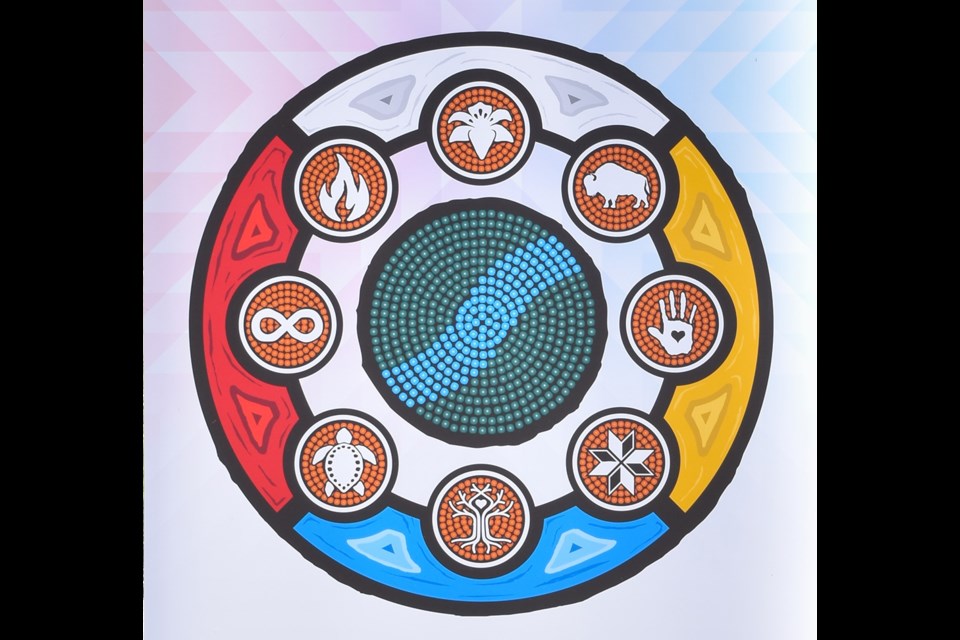SASKATOON — The City of Saskatoon continued its work to lead the community towards Truth and Reconciliation by revealing the Reconciliation Visual Identity on Monday, May 29, coinciding with the Reconciliation flag-raising ceremony at Civic Square.
The city's Reconciliation Visual Identity, a logo, results from a year-long engagement with a working group composed of 12 community members, including elders, knowledge keepers, and residential school survivors.
"Every year, the City of Saskatoon hosts the [Reconciliation] flag-raising ceremony to start National Indigenous People's Month. We worked with the Saskatoon Survivors Circle, and they advised us on how to do it," said Truth and Reconciliation Co-ordinator Warren Isbister-Bear.
"We also have a teepee. Three young artists painted the teepee at the Remai [Modern] art gallery, and they also painted our new visual identity."
He added that the Reconciliation Visual Identity began in 2019 as part of a no-cost Reconciliation Action and Measurement Pilot Project, with the Office of the Treaty Commissioner reviewing and measuring the city's progress in its work towards reconciliation.
"The visual identity started as a direct recommendation after assessing the reconciliation report from the Office of the Treaty Commissioner. They advised us on a series of recommendations. One of them is to create a visual identity and presence for reconciliation," said Isbister-Bear.
"We assembled the group of survivors, Knowledge Keepers, and people working towards reconciliation in Saskatoon to be part of the advisory committee to develop the logo. We had a series of consultations with them."
Jennifer Altenberg, Wilfred Burton, Carrie Catherine, Nora Cummings, Rick Daniels, Corine Eyahpaise, Judy Greyeyes, Florence Highway, Gilbert Kewistep, Evelyn Linklater, Dorah Montgrand, and Judy Pelly were the members of the advisory committee.
Based on the ideas agreed upon by the advisory committee, the consultation result was designed by Métis brand specialist Colin McFayden of National Brand after being commissioned by the city.
The city's Reconciliation Visual Identity features an inner circle representing the Treaty promises to endure "as long as the sun shines, grass grows, and rivers flow." The centre depicts Saskatchewan's rivers and prairies.
It incorporates green, the City of Saskatoon's colour palette, and blue beadwork, showcasing the beauty and pride of Indigenous art. The colours also symbolize two of the four elements: water and earth.
The outer circle is divided into four sections, as the number holds sacred significance for Indigenous Peoples, who view medicine as having four parts. The number four is connected to the seasons, elements, directions, stages of life, colours of humanity, heart chambers, body quadrants, and brain sections.
The four puffs represented in the design are derived from the ceremonial pipe smoking tradition and water pouring four times over hot rocks in sweat lodges. The four colours represent the north (white for wind), east (yellow for fire), south (blue for water), and west (red for earth).
The north (white) of the medicine wheel represents Saskatoon's Inuit people, while the trusses symbolize the City of Bridges, with tension and compression forming a solid foundation of interconnectivity.
Inside the medicine wheel, eight icons are included: the prairie lily (representing the good life), bison (symbolizing respect), hand (highlighting Missing and Murdered Indigenous Women and Girls and Two-Spirit Persons), the Reconciliation Saskatoon symbol (representing partnership and inclusivity), tree (with roots symbolizing being grounded in the community), turtle (representing Turtle Island and respect for the land), infinity symbol (denoting Métis endurance), and fire (defining traditions).
The Reconciliation Visual Identity brand will be used in city-related web content, videos, posters, banners, signage, e-newsletters, decals, flags, billboards, and other mediums to convey Saskatoon's commitment to reconciliation. Permission for any use of the brand must be obtained from the City of Saskatoon's Indigenous Initiatives Department.




